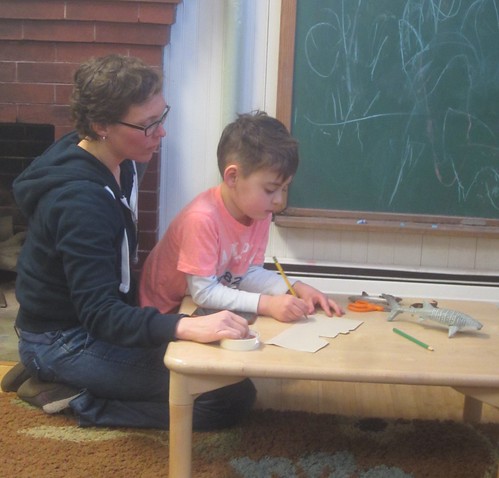 We were so grateful that the first week of spring was truly spring-like with sunny days bringing above freezing temperatures. A soup shop was set up, selling concoctions such as chocolate peanut butter soup, and chocolate raspberry soup. Games of Duck, Duck, Goose, Red Light, Green Light, and What Time Is It Mr. Fox? were played. The sledding hill continued to be busy with sledders and snowboarders. We dug out our drainage trench again, so the melting snow and ice had an outlet. The spring water play is one of our favorite activities, so the afternoon students were able to enjoy scooping up shovelfuls of water and filling buckets with ice, snow, and muddy H2O during their afternoon trips out to enjoy the sun and warmth.
We were so grateful that the first week of spring was truly spring-like with sunny days bringing above freezing temperatures. A soup shop was set up, selling concoctions such as chocolate peanut butter soup, and chocolate raspberry soup. Games of Duck, Duck, Goose, Red Light, Green Light, and What Time Is It Mr. Fox? were played. The sledding hill continued to be busy with sledders and snowboarders. We dug out our drainage trench again, so the melting snow and ice had an outlet. The spring water play is one of our favorite activities, so the afternoon students were able to enjoy scooping up shovelfuls of water and filling buckets with ice, snow, and muddy H2O during their afternoon trips out to enjoy the sun and warmth.

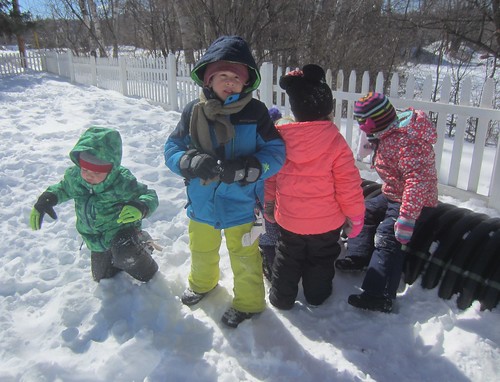







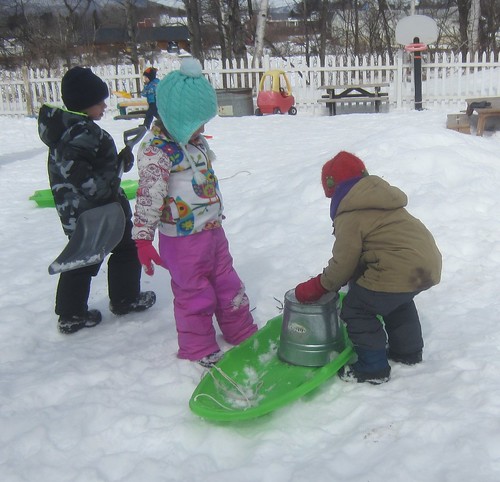








 For Monday art we did some weaving, a rather tricky concept. Using fish shapes, the children selected fancy papers and carefully wove them through slits in the fish to create checkerboard patterns. It took some good finger-work, strategizing, and focus to get them properly woven. It was a bit of a challenge, but everyone found success!
For Monday art we did some weaving, a rather tricky concept. Using fish shapes, the children selected fancy papers and carefully wove them through slits in the fish to create checkerboard patterns. It took some good finger-work, strategizing, and focus to get them properly woven. It was a bit of a challenge, but everyone found success!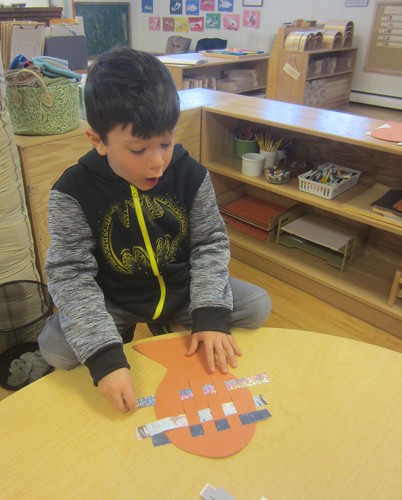





 Last week the children voted and decided to change dramatic play to an aquarium. We had a discussion on Tuesday morning about what happens at an aquarium. Children who have visited aquariums shared that their experiences involved walking around and looking at the animals, and some had the chance to experience a touch tank. After hearing about their experiences, everyone decided to make it more interactive and turn it into an ocean where we could swim, snorkel, scuba dive, submerge in shark tanks, and dive down in a submarine. They brainstormed all sorts of things that we would need to include and immediately got busy making various sea creatures, including spiny sea stars, jellyfish, an octopus, a sea turtle, hanging kelp, ocean murals, and of course a yellow submarine to go along with the song. Everyone was busy and excited to set it up.
Last week the children voted and decided to change dramatic play to an aquarium. We had a discussion on Tuesday morning about what happens at an aquarium. Children who have visited aquariums shared that their experiences involved walking around and looking at the animals, and some had the chance to experience a touch tank. After hearing about their experiences, everyone decided to make it more interactive and turn it into an ocean where we could swim, snorkel, scuba dive, submerge in shark tanks, and dive down in a submarine. They brainstormed all sorts of things that we would need to include and immediately got busy making various sea creatures, including spiny sea stars, jellyfish, an octopus, a sea turtle, hanging kelp, ocean murals, and of course a yellow submarine to go along with the song. Everyone was busy and excited to set it up.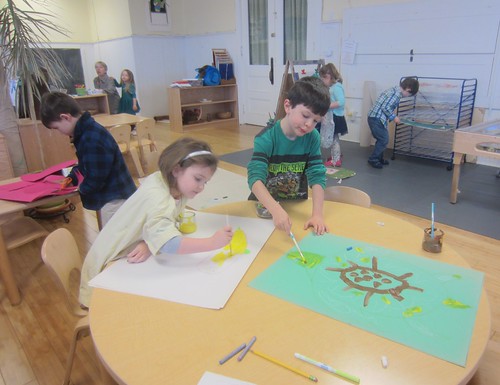











 For Spanish on Tuesday Zeanny concluded our second session with another cooking activity. This time we made cajetas with crushed graham crackers, which we mixed with sweetened condensed milk and rolled in chocolate sprinkles. Before we got to the crushing, mixing, scooping, and rolling, Zeanny told us the story of The Chocolate Tree, one of my very favorite Zeanny stories. Ask your child to share it with you if they have not already! Who knew that there really is such a thing as a chocolate tree that grows chocolate. They can tell you all about how Zeanny did not listen to her abuelita and ate the chocolate even after being told, “No lo comas!” (Don’t eat it!), and what happened.
For Spanish on Tuesday Zeanny concluded our second session with another cooking activity. This time we made cajetas with crushed graham crackers, which we mixed with sweetened condensed milk and rolled in chocolate sprinkles. Before we got to the crushing, mixing, scooping, and rolling, Zeanny told us the story of The Chocolate Tree, one of my very favorite Zeanny stories. Ask your child to share it with you if they have not already! Who knew that there really is such a thing as a chocolate tree that grows chocolate. They can tell you all about how Zeanny did not listen to her abuelita and ate the chocolate even after being told, “No lo comas!” (Don’t eat it!), and what happened.





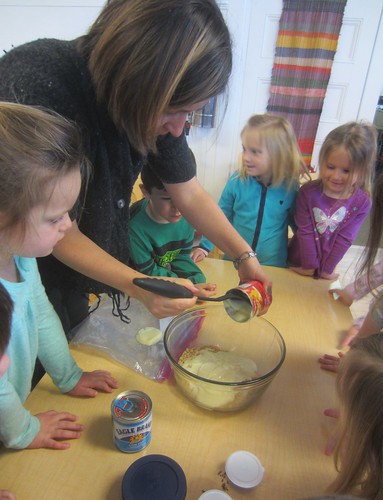








 We read the book Ocean Sunlight by Molly Bang, about how the sun gives light to all the billions of billions of billions of phytoplankton in the seas that feed the sealife in all the oceans. We discussed food chains and how every living thing depends on plants, even if they eat other animals, to sustain life. We are loving our phytoplankton song about the food chain. By April the children will likely be able to sing it for you at home!
We read the book Ocean Sunlight by Molly Bang, about how the sun gives light to all the billions of billions of billions of phytoplankton in the seas that feed the sealife in all the oceans. We discussed food chains and how every living thing depends on plants, even if they eat other animals, to sustain life. We are loving our phytoplankton song about the food chain. By April the children will likely be able to sing it for you at home!
Seahorses, which are a type of fish, were introduced. We read several stories about seahorses and learned that they have heads shaped like horses, prehensile tales like monkeys, hard outer skin like grasshoppers, pouches like kangaroos, camouflaging skin and independently moving eyes like chameleons. We also learned that the father seahorses are the ones that give birth to the babies after the mothers deposit the eggs into their pouches, where they remain until they are born – all 300 at a time!
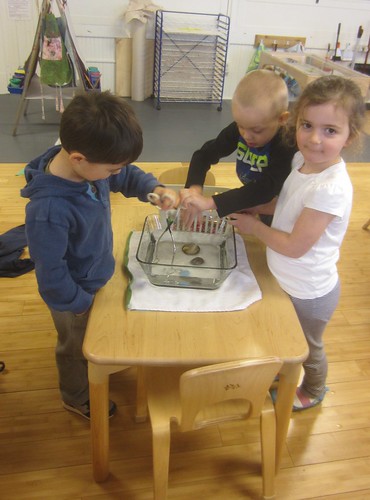
















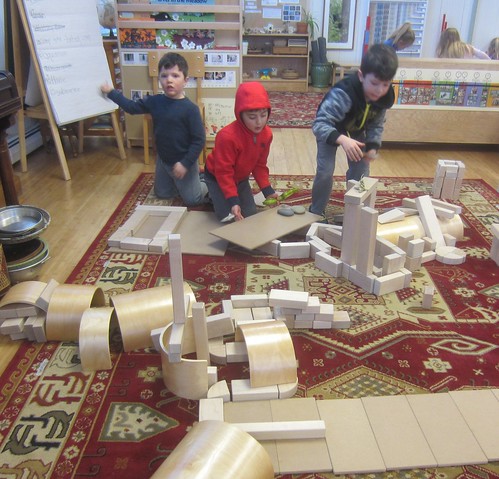




 We did some role playing and were introduced to the word MISUNDERSTANDING. We are working on perspective taking, which research by Larry Aber of New York University has demonstrated has the most impact on a child’s ability to step back from a situation to accurately assess a situation and handle conflict, particularly for those who see any offense as deliberately hostile. We will continue to work on perspective taking, including taking a step back and reading a situation then deciding how to proceed.
We did some role playing and were introduced to the word MISUNDERSTANDING. We are working on perspective taking, which research by Larry Aber of New York University has demonstrated has the most impact on a child’s ability to step back from a situation to accurately assess a situation and handle conflict, particularly for those who see any offense as deliberately hostile. We will continue to work on perspective taking, including taking a step back and reading a situation then deciding how to proceed. During music time with Susan we had fun singing the fish song and sharing what our wish would be if we were a fish. We sang My Bonnie Lies Over the Ocean and every time we sang a word that began with /B/ we went up or down. We took turns holding and ringing bells, and putting them in order from highest to lowest. It was VERY tricky! Everyone got a turn with a bell and some of the children were right on with identifying higher and lower tones.
During music time with Susan we had fun singing the fish song and sharing what our wish would be if we were a fish. We sang My Bonnie Lies Over the Ocean and every time we sang a word that began with /B/ we went up or down. We took turns holding and ringing bells, and putting them in order from highest to lowest. It was VERY tricky! Everyone got a turn with a bell and some of the children were right on with identifying higher and lower tones.
 For Friday science we watched a short video about a submarine that submerged down through the zones, and as they traveled down they described the zones and what they saw there. We learned about the sunlight zone, twilight zone, midnight zone, the abyss, and the hadal zone. We learned that the sunlight zone is where photosynthesis takes place, and although it is only a very small portion of the ocean, it is where the majority of ocean-life lives. We discussed water pressure, and how dark and cold it is the further down in the ocean you go. Some of the children took turns laying on top of each other to see how the pressure builds when there is more weight on top of you, and we discussed how heavy a bucket of water is, so all that water pressing down is heavy! We then constructed our own display of the zones and each of the children drew, colored, cut out, labeled, and taped up a fish in it’s proper zone.
For Friday science we watched a short video about a submarine that submerged down through the zones, and as they traveled down they described the zones and what they saw there. We learned about the sunlight zone, twilight zone, midnight zone, the abyss, and the hadal zone. We learned that the sunlight zone is where photosynthesis takes place, and although it is only a very small portion of the ocean, it is where the majority of ocean-life lives. We discussed water pressure, and how dark and cold it is the further down in the ocean you go. Some of the children took turns laying on top of each other to see how the pressure builds when there is more weight on top of you, and we discussed how heavy a bucket of water is, so all that water pressing down is heavy! We then constructed our own display of the zones and each of the children drew, colored, cut out, labeled, and taped up a fish in it’s proper zone.






